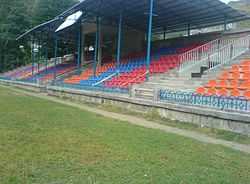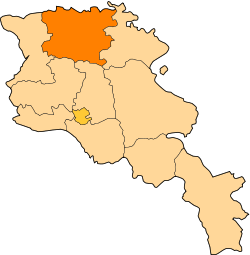Alaverdi
- For the monastery, see Alaverdi Monastery.
- In Georgian culture, the alaverdi is the person granted the right to speak right after the toastmaster, see Tamada.
Coordinates: 41°08′N 44°39′E / 41.133°N 44.650°E
| Alaverdi | |
|---|---|
|
Alaverdi skyline • Residential blocks Lori Mountains overlooking the town • Debed canyon Sanahin bridge of 1195 • Debed River The copper plant seen from the cable car • Narekatsi church | |
 Alaverdi | |
| Coordinates: 41°08′N 44°39′E / 41.133°N 44.650°E | |
| Country |
|
| Marz | Lori |
| First mentioned | 17th century |
| Government | |
| • Mayor | Artavazd Varosyan |
| Area[1] | |
| • Total | 18 km2 (7 sq mi) |
| Elevation | 1,000 m (3,000 ft) |
| Population (2009) | |
| • Total | 16,500 |
| • Density | 920/km2 (2,400/sq mi) |
| Time zone | UTC (UTC+4) |
| Area code(s) | (+374)253 |
| Website | official website |
| Sources: Population [2] | |
Alaverdi (Armenian: Ալավերդի, Armenian pronunciation: [ɑlɑvɛɾˈdi]) is a town in the Lori Province at the northeastern part of Armenia, not far from the border with Georgia. With an approximate population of 16,500 inhabitants (down from 26,300 in 1989), Alaverdi is situated at the bottom of the Debed river gorge. The town is one of the important commercial and industrial centres of the district and the entire republic. It is located at the only direct rail link between Armenia and Georgia. Alaverdi was formerly known as Manes.
History

Historically, the area of Manes-Alaverdi was part of Dzoropor canton of Gugark province of Greater Armenia. Starting from the 17th century, the settlement became to be known as Alaverdi which is derived from the name Alvert which means red stone,probably this is due to the fact of copper mines exploration in the region of Alaverdi from ancient times.
When the area was annexed to the Russian Empire at the end of the 18th century, a number of Pontic Greek miners were resettled in the area to start exploiting the copper, through the efforts of the Argoutinski-Dolgoruki family. Soon after, nearly a quarter of the entire Russian copper was being mined in Alaverdi. At the end of the 19th century, the concession to exploit the mine was sold to a French firm. During the Soviet rule in the 20th century, the town acquired its current socialist industrial appearance. After the independence, the metallurgical plant was privatized to become a major employer for the town and its surroundings.
Alaverdi has many historical structures, including the 12th-century bridge of Sanahin.
However, many other important cultural monuments are located in the vicinity of the town, including the monasteries of Sanahin, Haghpat, Kobayr, Akhtala, Khorakert, Khuchap, Ardvi and a basilica in Odzun.
Industry
During the Georgian rule over Alaverdi region, the Alaverdi Copper Smelter was founded in 1770, by the order of Georgian king Erekle II. At the end of the 19th century, the region was flourished through the growing Russian and French investments in metallurgical business. In 1903, the amount of copper produced in Alaverdi region made around 13% of the total copper production in the Russian Empire.
By the end of 1909, the hydropower plant of Debed river was inaugurated in order to provide the developing metallurgical plants with sufficient energy.
During the Soviet rule, massive construction works were carried on in Alaverdi, including the surrounding areas of Sanahin and other villages. The Soviets made significant steps for the enlargement of the metallurgical industry in the region, which has turned Alaverdi from a small industrial settlement to a modern town within Soviet Armenia.
Recently, new plans were introduced for the expansion of copper production in Alaverdi smelter and the development of new copper mines within the frameworks of the "Armenian Copper" project.
Around 500 job opportunities are secured by the copper factory.
Education and religion

The first educational centre in the area of Alaverdi was the University of Sanahin, which was opened in 966 AD by the efforts of the Bagratuni queen Khosrovanush.
The town is one of the important educational centres in Lori. As of 2009, 10 public education schools are operating in Alaverdi with nearly 2,000 students, and 6 nursery schools with more than 400 kids.
The State College of Alaverdi offers an opportunity in pedagogical studies with a duration of two years, while the Tumanynan branch of the Northern University offers degrees in nursing and dental prosthesis.
A music academy named after Romanos Melikian and 3 schools of art are functioning in Alaverdi, with a total number of 600 students (as of 2009).[3]
The Alaverdi cultural palace was founded in 1997. It consists of a large theatre hall and a big public library.
In November 2001, the church of Saint Gregory of Narek was opened in Alaverdi through the efforts of the Alaverdi Copper Plant, the Diocese of Gougark and the local citizens of the town.[4]
Sport
Alaverdi is one of the major centres of sports in Armenia. In 1936, the Metallurg Football Club of Alaverdi had participated in the lower levels of the first ever Soviet football championship, representing the Armenian SSR.
After the independent of Armenia in 1991, Debed FC of Alaverdi had participated in the Armenian Premier League during the 1992 season. However, like many other Armenian football clubs, Debed FC was dissolved in 1993 and is currently inactive from professional football.
However, the organizations in Alaverdi are very poor, but some plans have been implemented by the Football Federation of Armenia to promote the game in the province of Lori, therefore the town's only stadium; the Metallurg Stadium, was recently turned into an all seater stadium with a capacity of 1,400 seats to serve many young football teams and sport-schools.
During the Soviet period, the town used to have a strong handball team. The handball training academy of Alaverdi named after Oleg Gorbunov (Soviet handball player during the 1960s), is still operating in the town since 1962.[5]
Chess and boxing training academies are operating in the town since 2006.
Nature and nearby attractions
The area around Alaverdi is rich with historical monuments and natural life. The town itself is built in the canyon of Debed river, surrounded with high mountains and green forests. Many samples of the Armenian architectural heritage are located near the town of Alaverdi:
- Odzun Church of the 5th century.
- Horomayr Monastery of the 7th century near Odzun village.
- Surp Hovhannes church of Ardvi from the 8th century.
- Kaytson Castle of the 9th century located near the shores of Debed river.
- Sanahin Monastery founded in the 10th century.
- Haghpat Monastery of the 10th century.
- Church of the Forty Martyrs from the 11th century.
- The medieval bridge of Sanahin near Alaverdi, built in 1195.
- Kayan Berd, a black fortress built in 1233 near Alaverdi.
- House-museum of Hovhannes Tumanyan, located in Dsegh village near Alaverdi.
Demographics
Alaverdi is mainly inhabited by ethnic Armenians with a minor Greek community that was once considered the largest in Armenia. The Greeks in Armenia speak the Pontic dialect and they are fluent in both Armenian and Russian. The Madan neighbourhood of Alaverdi used to have a large Greek community, until the end of Soviet rule.[6]
| Year | Population |
|---|---|
| 1916 | 1,185 |
| 1939 | 10,000 |
| 1959 | 16,805 |
| 1965 | 24,600 |
| 2008 | 13,225 |
Sister cities

-
 Kobuleti, Georgia, since 28 May 2007.[7]
Kobuleti, Georgia, since 28 May 2007.[7] -
 Agios Ioannis Rentis, (municipality in Athens), Greece, since 1 October 2007.[8]
Agios Ioannis Rentis, (municipality in Athens), Greece, since 1 October 2007.[8]
References
- ↑ ArmeniaInfo
- ↑ Armstats:Population
- ↑ "Education in Alaverdi". Alaverdi town official website. Retrieved 2009-08-14.
- ↑ Alaverdi Church
- ↑ "Sport in Alaverdi". Alaverdi town official website. Retrieved 2009-08-24.
- ↑ The Ethnic Minorities of Armenia, Garnik Asatryan, Victoria Arakelova.
- ↑ "Sister cities". Alaverdi town official website. Retrieved 2009-08-24.
- ↑ "Sister cities". Alaverdi town official website. Retrieved 2009-08-24.
- Alaverdi at GEOnet Names Server
- Report of the results of the 2001 Armenian Census, National Statistical Service of the Republic of Armenia
- http://www.alaverdi.am/index.php?option=com_content&view=category&layout=blog&id=103&Itemid=462&lang=hy Treasures of Alaverdi
External links
| Wikimedia Commons has media related to Alaverdi. |


